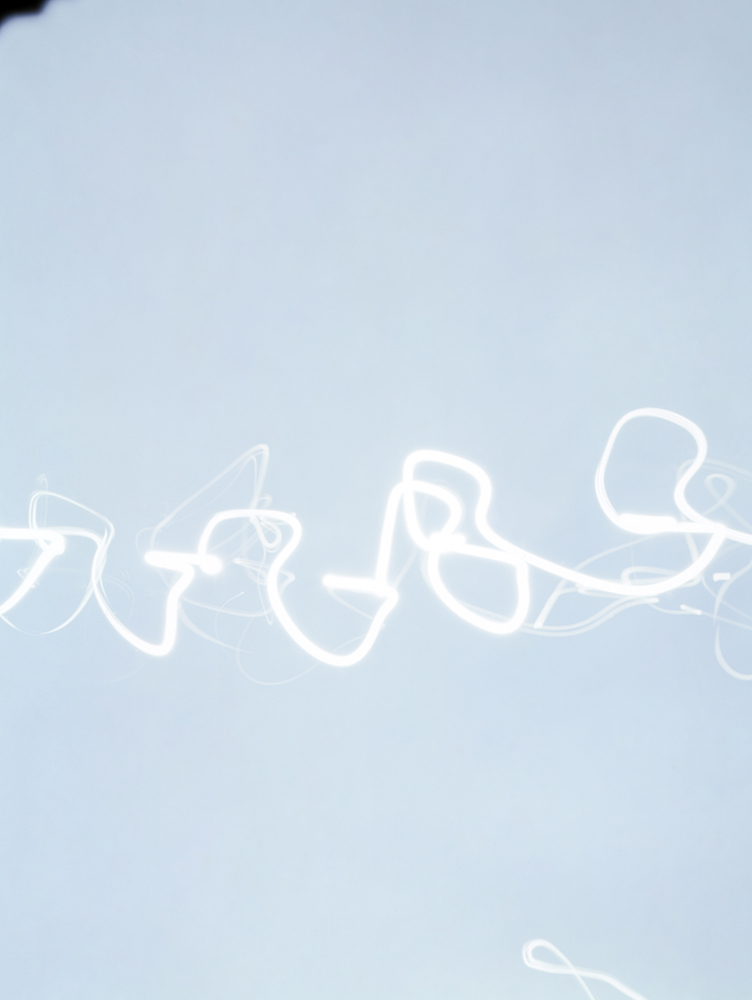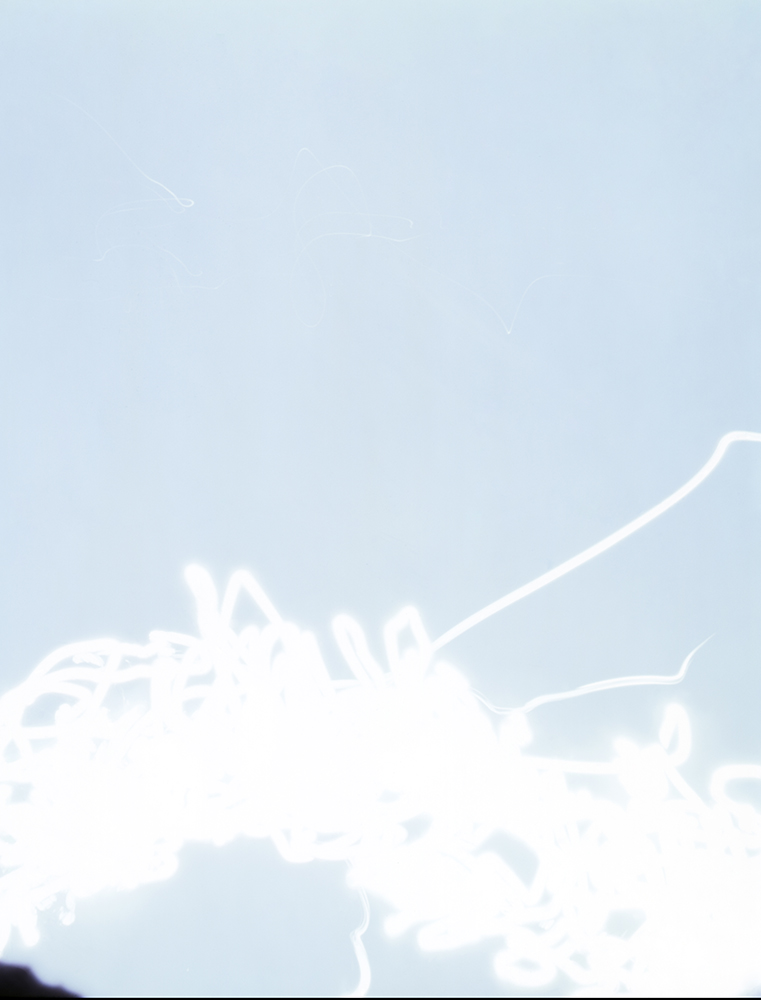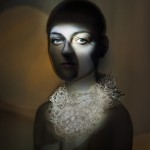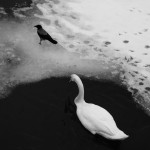The Dynamics of Photography and Disability: Megan Bent: I Don’t Want To Paint A Silver Lining Around It
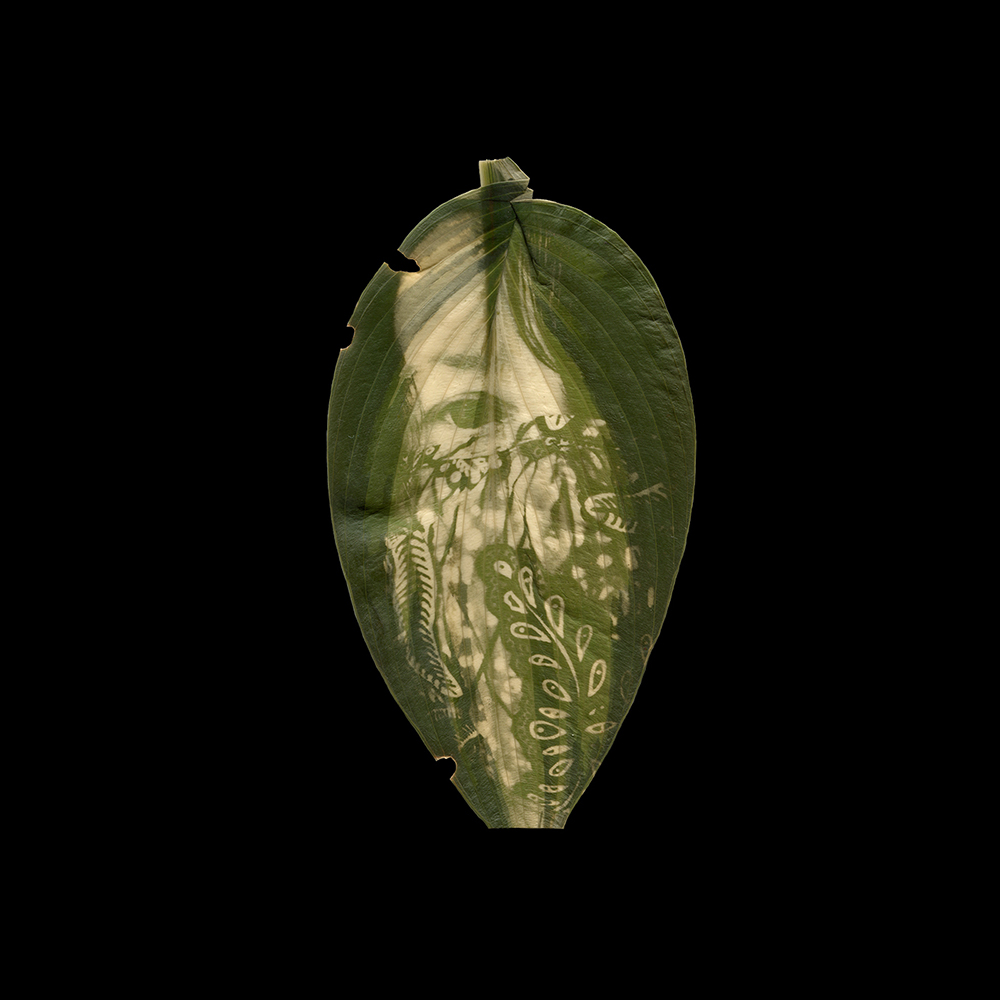
©Megan Bent, Quarantine Day 121, 2020, Chlorophyll print. Image description: A teardrop-shaped hosta leaf on a black background. Printed in the chlorophyll is a self-portrait while wearing a face mask. I am a disabled white woman and my pale face takes up the whole leaf and only one eye is visible through overgrown sweeping hair. The face mask is decorated with a vine and leaf patterns.
I had the pleasure of meeting artist Megan Bent and her work at Review Santa Fe a few months ago. I was not only struck by her work, but also by her person and advocacy. As a person with chronic illness, the pandemic was a time of high risk and high stress and Bent used the quarantine to create a project, I Don’t Want To Paint A Silver Lining Around It. Working with nature to produce chlorophyll prints, she connects the fragility of disability and the fragility of nature. I am so grateful that Bent, our editor for this week, for featuring projects that speak to “The Dynamics of Photography and Disability”. Today we begin with her work.
Megan Bent is a lens-based artist interested in the malleability of photography and the ways image-making can happen beyond using a traditional camera. This interest started to occur after the diagnosis of a progressive chronic illness. Drawn to image-making processes that reject perfection, accuracy, or any certainty in results, she is interested instead in processes that reflect and embrace her disabled experience; especially interdependence, impermanence, care, and slowness
Her artwork has been exhibited nationally at The Halide Project in Philadelphia, PA, The Center For Fine Art Photography in Fort Collins, CO; The East Hawaiian Cultural Center/HMOCA in Hilo, Hawai’i; Flux Factory in Long Island City, NY; El Museo Cultural, Santa Fe, NM; The Foster Gallery, in Dedham MA; Soho Photo Gallery in Tribeca, NY; the Austin Central Library Main Gallery in Austin, TX, and internationally at F1963 in Busan, South Korea; Alternative Space 298, Pohang, South Korea; and Fotosotrum in Barcelona, Spain.
She is currently an artist in residence at Art Beyond Sight’s Art + Disability Residency and has been an artist in residence at the Nobles School in Dedham, MA, and the Honolulu Museum of Art, HI. She has presented her work at Atlas Obscura: The Secret Arts, The Pacific Rim International Conference on Disability and Diversity in Honolulu, HI, at Other Bodies: (Self) Representation, Disability and the Media at the University of Westminster in London, U.K., and at Critical Junctures at Emory University in Atlanta, GA. Her work has been featured in Analog Forever Magazine, Fraction Magazine, Too Tired Project, Rfotofolio, and Float Photography Magazine.
Follow Megan Bent on Instagram: @m_e_g_g_i_e_b
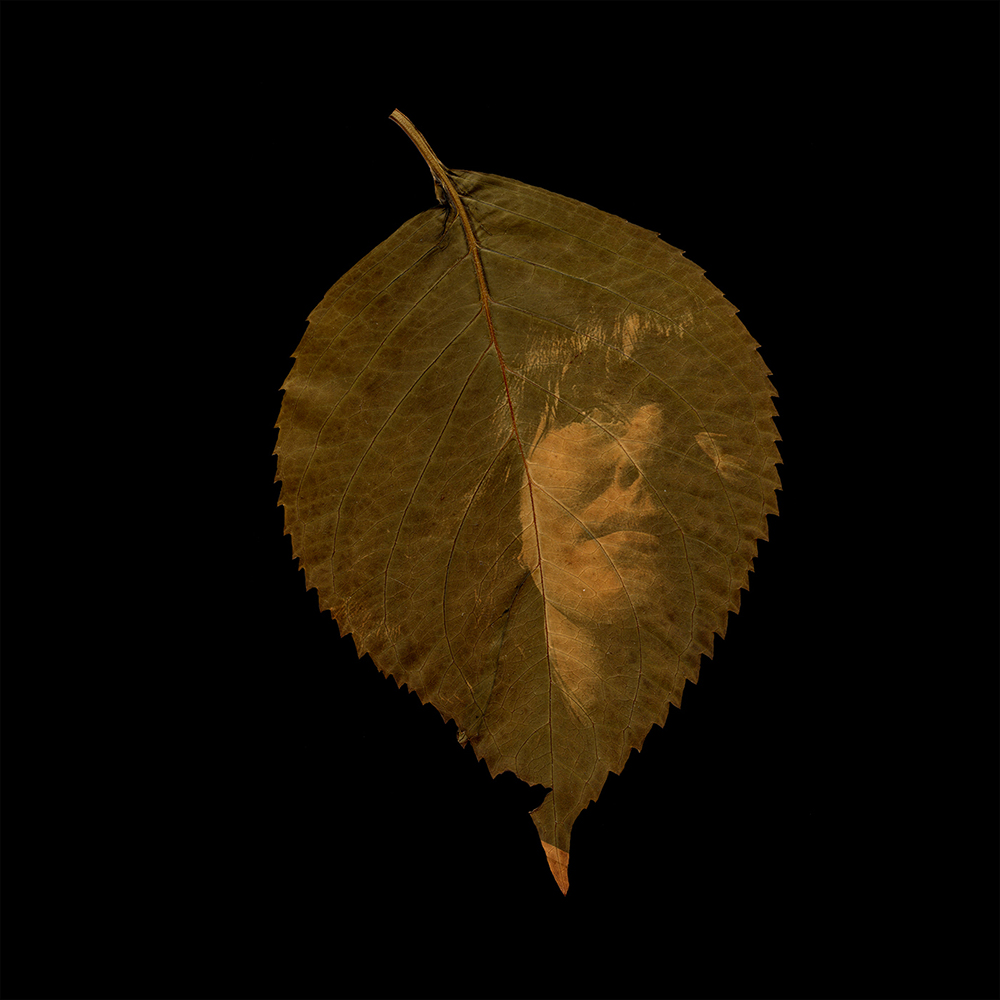
©Megan Bent, Quarantine Day 7, 2020, Chlorophyll print. Image description: A round brown hydrangea leaf on a black background. Printed in the light umber chlorophyll is a self-portrait where half my face is lit by the sun and my head and eyes are tilted up-ward.
I Don’t Want To Paint A Silver Lining Around It
In March of 2020, my fear of catching the Coronavirus became palpable. “Don’t worry,” an acquaintance assured me “only the sick and elderly will die.” I am chronically ill and immunocompromised. I Don’t Want To Paint A Silver Lining Around It is my personal reflection of being high risk in the pandemic. It is also my response to the outside world’s demand that disabled people be acceptable losses for personal convenience or for corporate profit.
Through chlorophyll printing, which uses UV light to print photographic images directly onto leaves, I connect disability and nature to undermine stereotypical representations of disability as tragic and reframe it as a valuable part of human diversity. The chlorophyll printing process (where one print/exposure may take anywhere from 8-72 hours) relies on flexibility, interdependence with nature, and echos my experience of the disability concept of Crip Time, living in a body/mind that values slowing down, connection, and care over speed and production. The fact that chlorophyll prints are impermanent, and will continue to decay over time, asks the viewer to confront the interdependence and bodily impermanence we all share.
Aline Smithson: What was the landscape of your childhood and what brought you to photography?
Megan Bent: I grew up in rural Connecticut. I feel very lucky that around the corner from my house was this expansive and beautiful state park. So I spent a lot of my childhood outdoors and in the woods. I love being outside and in nature. It is really healing for me. And when I can, I love going back to the park I grew up near, it’s a really special place to me.
I would say that disability brought me to photography. When I was a teenager I had a TBI (traumatic brain injury). The injury affected parts of my brain that control memory recall and vocabulary. It was a difficult time. My brain was healing, I was having to learn new skills for navigating life in a new way. Around that time my brother gave me a point and shoot camera and not long after that my parents sent me on a cross country trip by train to have new experiences and for some personal healing. And the trip really was healing. I took so many photographs, the camera became this tool that connected me to my memories (“having been there”) and connected me back to myself. It gave me confidence to be able to create and communicate in a new way. This trip was back before digital was really a thing and I remember I was so excited to see my film that I would literally wait outside the one hour photo lab to be able to look at my pictures the instant they were done. I returned from that trip saying I wanted to be a photographer. I’m really grateful for the ways this medium has helped empower me and give me voice. I am also so grateful that all these years later I still have that same level of excitement about getting to look at my film or alt process prints for the first time.
AS: What does disability mean to you?
MB: Disability is such an expansive term for me. It is a part of my identity and is wrapped up in every aspect of my life. I think a lot about the disconnect in how I experience disability and the mainstream representations/understanding of disability. I experience disability as part of my identity, as a community that has a history and culture but I think in mainstream representations disability is still very much depicted as something to pity, fear, fix, or be inspired by.
To me disability is rich, multifaceted, it is ingenuity, creativity, beauty, fortitude. Disability is intersectional, part of every community. Disability has an aesthetic. Many disability theorists talk about how disability will at some point touch everyones life, which I also agree with.
AS: Can you explain Disability Culture?
MB: I think disability culture, like the term disability, can mean different things to different people. To me disability culture is moving beyond disability in relation to the medical model/fix/cure structure and moving accessibility beyond compliance, and thinking of disability as a marker of identity one claims, having a rich history, community, ways of creating and making that come from our lived experiences. It’s subverting capitalist ideals and creating spaces that are built on care networks. It’s having space to share your disability experience in all its vastness with people who get it, its access intimacy – a term coined by Mia Mingus, as “The intimacy I feel with many other disabled and sick people who have an automatic understanding of access needs out of our shared similar lived experience of the many different ways ableism manifests in our lives. Together, we share a kind of access intimacy that is ground-level, with no need for explanations. Instantly, we can hold the weight, emotion, logistics, isolation, trauma, fear, anxiety and pain of access. I don’t have to justify and we are able to start from a place of steel vulnerability. “
Disability culture has been shaped by our crip* ancestors and is something we are currently building and shaping together.
Note: In this interview, I use the word Crip, a word that has been reclaimed by members of the disability community and disability activists.
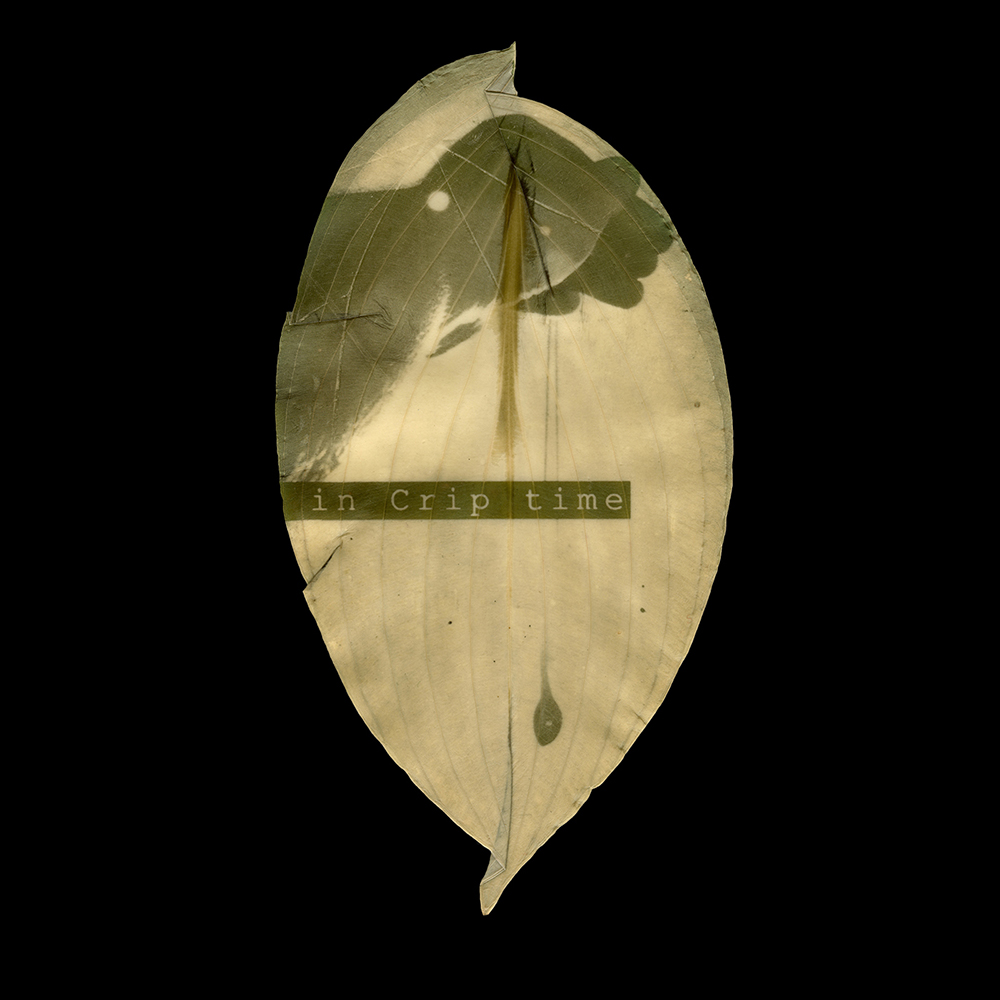
©Megan Bent, I Live In Crip Time, 2021, Chlorophyll print. Image Description: A vertical hosta leaf on a black background. Printed in the chlorophyll is a hand holding a necklace with a spoon pendant up to the sun. In the middle is a black text box with white text “in Crip Time”.
AS: Thank you so much for being this week’s Editor sharing work from disabled/chronically ill photographers. How did you select the artists?
MB: Thank you for having me, it has been such a wonderful experience and I have loved connecting and conversing with each of the artists. I want to start by saying that the artists featured this week are artists whose work I admire and have been following for some time. There are so many talented disabled photographers making work that challenges normative ideas and structures, and the artists featured this week are just a beginning, this list is not exhaustive. Some of the photographers featured I know and have worked with before and some of the photographers are people whose work I admire and follow and with whom I really wanted to connect and know more about their practice.
I chose the title The Dynamics of Photography and Disability for this week because I think that we are all approaching disability and photography in different and dynamic ways. So in a sense when I talk about the richness of disability culture, I think it’s present in the work and ideas shared this week.
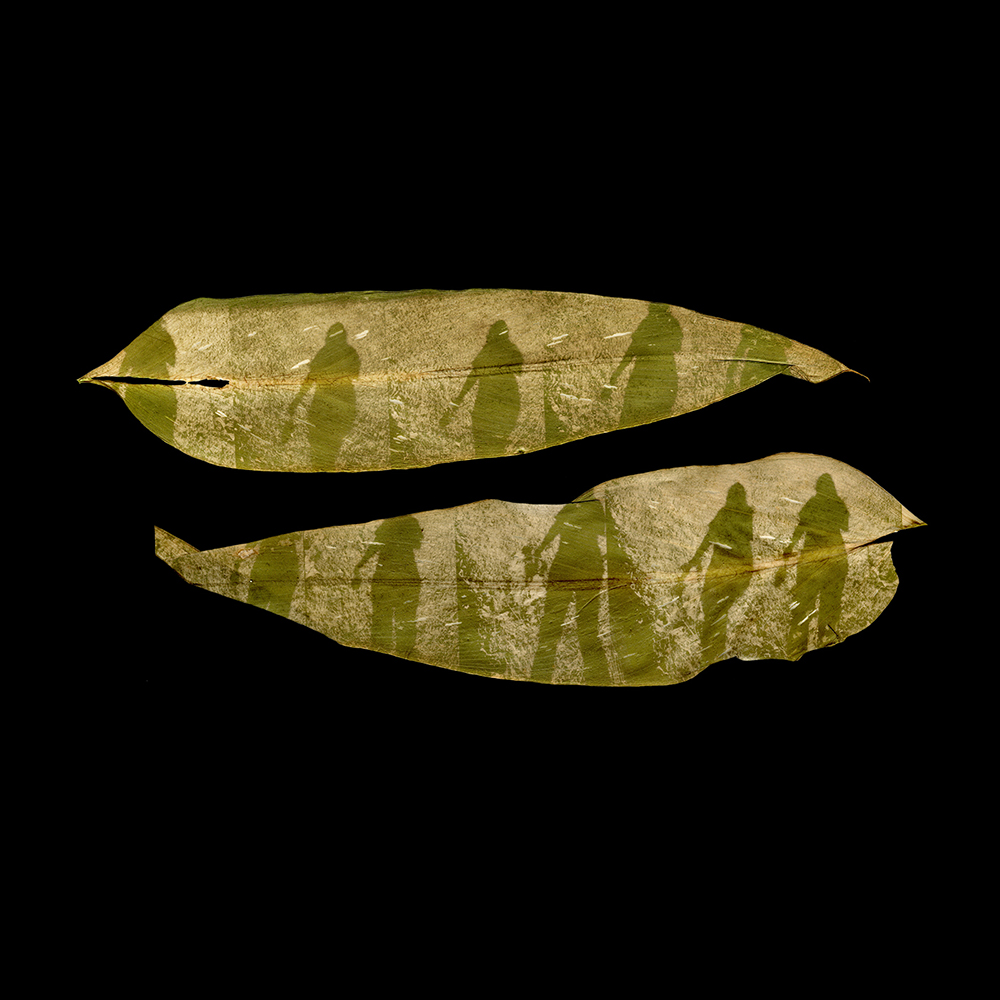
©Megan Bent, Quarantine Day 450, 2021, Chlorophyll print. Image Description: Two calla lily leaves placed horizontally on a black background. On each leaf, printed in the chlorophyll, is a cascading series of my shadow as I walk.
AS: Art is such an incredible tool for healing. I love what you state in your bio: “Drawn to image-making processes that reject perfection, accuracy, or any certainty in results, she is interested instead in processes that reflect and embrace her disabled experience; especially interdependence, impermanence, care, and slowness.” How has having the outlet of creating art affected your life and artistic journey?
MB: I think art is the way I process what is going on, a tool to process things in a meaningful way and a way to assert my voice. Like I mentioned earlier I found photography during a period when I was having difficulty with my memory and vocabulary and it became this really powerful way for me to express myself and feel connected to place, memory, and agency through this act of making.
When I was first diagnosed with my autoimmune disease I was really open about it but I quickly faced a lot of stigma. People started treating me differently, like I was all of a sudden less capable and couldn’t make decisions for myself. It was really disempowering.
When I started my MFA program at the University of Hawai’i at Manoa, I also took courses in Disability Studies and it just changed everything. I started making work about being disabled and claiming disability for myself. I started reading works by disability theorists – and their stories and ideas were putting words to these feelings I had been having but didn’t have the vocabulary for yet. Ideas about how disability is seen socially, the ways we can challenge, through our creative lived experience normative capitalist structures, learning how the word/concept normal was conceived as a tool for othering. I think about that a lot, especially during the pandemic and calls for “returning to normal” ….
So as I started to make work about my disability, opening up about being disabled, it was really scary but also really freeing. During this time I fell in love with research and was simultaneously learning about disability culture, disability artistry and researching the history of disability representation in photography. I learned that the medium I loved and that really helped me find myself has this horrific history of perpetuating pseudoscience and stigmatizing disability. Some examples are composite photography of Francis Galton or Eadweard Muybridge’s photography of institutionalized disabled people in Animal Locomotion.
I feel like at the core of my practice is a desire for self representation and creating work that is in conversation with the past historical misrepresentations of disability. I feel like I am talking back to the early eugenicist photographers and poking holes in their pseudoscience and use of the camera. I think I do this to reject their ideas whose harmful consequences are still engrained in societal ideas of what disability means, and to not gloss over or forget the oppressive histories of this medium.
I talk back and create meaning not just through my imagery but also the processes I use. I want every part of my photographic process to reject ableism. As I stated above I seek out and use photographic processes that reject speed and perfection and embrace processes that value and celebrate care, interdependence, slowness, softness, flexibility – values I find in the disability community.
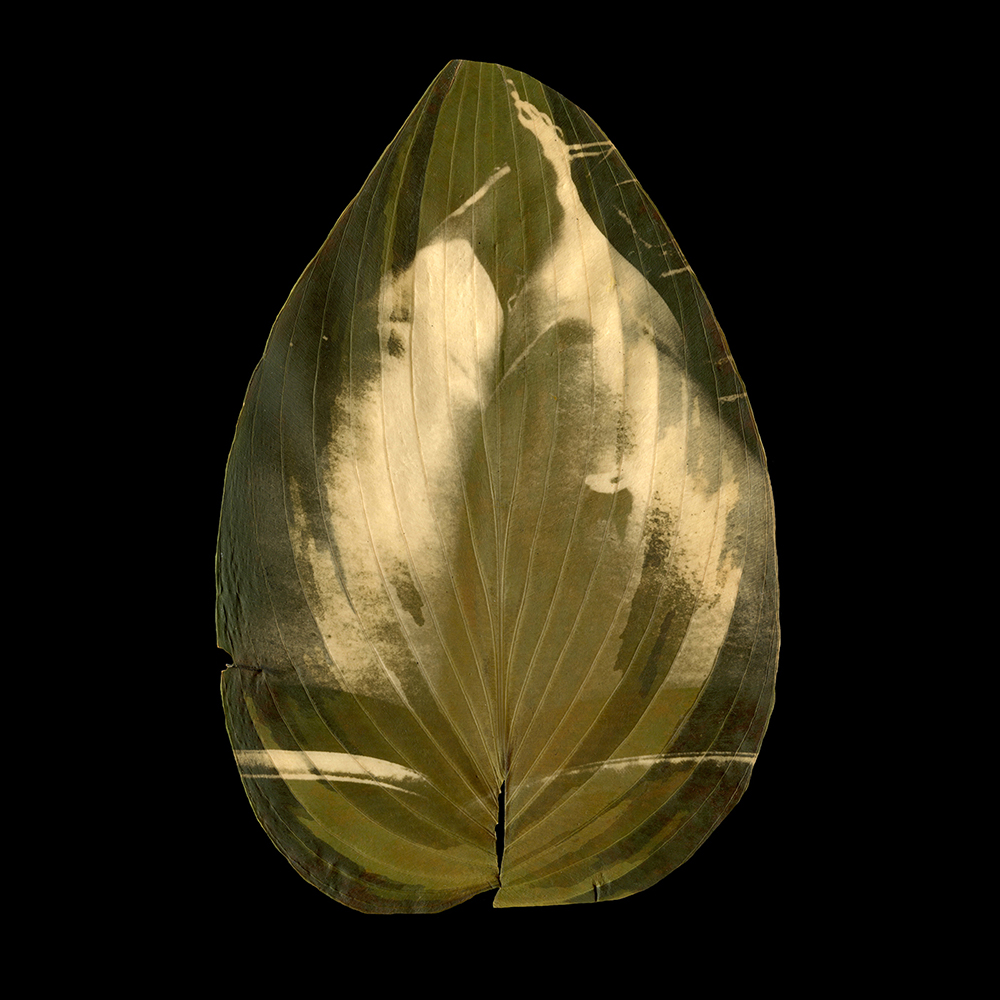
©Megan Bent, Quarantine Day 395 (Post Injection Radical Rest), 2021, Chlorophyll print. Image description: An oval-shaped hosta leaf on a black background. Printed into the chlorophyll are two white legs extended with feet bent in towards each other. On the right thigh is a small piece of tissue blotting the bleeding from an immunosuppressive injection.
AS: What was the impetus for your project, I Don’t Want To Paint A Silver Lining Around It?
MB: At the very beginning of the pandemic I felt like a canary in the coal mine. Understanding that health is not a given, that you can do “everything right” and still become ill, I started taking precautions early on. I had acquaintances tell me “not to worry because only the sick and elderly will die.” I am chronically ill and immunocompromised. And at the same time I felt there was this pressure of toxic positivity, to make the best of the situation and just find the silver lining in the pandemic. But in this dissonance I realized that we’re not all living the same pandemic experience (and still are not). I knew ableism was active in society, it is something I have repeatedly experienced first hand before the pandemic, and I was really disturbed by the blatant and increased ableism that has become so commonplace during the pandemic. Again, I felt like I needed to use the creative process to talk back.
Since the Spring of 2020, I have been taking pictures that record the daily experience of being chronically ill/high risk during the pandemic and then chlorophyll printing them (a process where images are printed directly onto leaves using photosynthesis). The images I take are pretty banal; me at home, resting, going to the doctors, in treatment, the seasons changing, going for walks. I felt like the images needed to match my existence and not dramatize or sugarcoat it. I have also been making images that address the blatant ableism occurring (calls to “sacrifice the weak”, fake ADA medical cards made and sold by anti-maskers, the recent comments from the director of the CDC – to name a few examples).
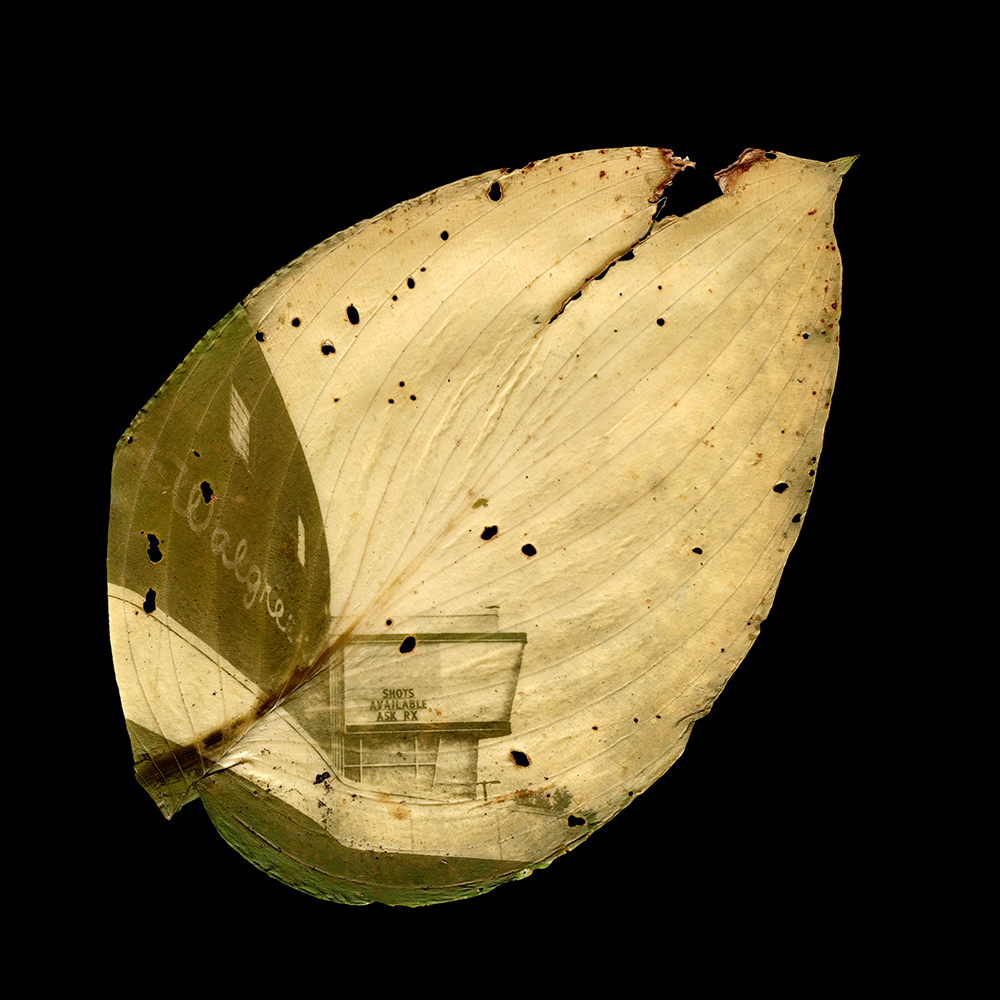
©Megan Bent, Quarantine Day 496, 2021, Chlorophyll print. Image Description: An oval-shaped hosta leaf on a black background. Printed into the chlorophyll is a building’s facade and a sign that reads “Shots Available. Ask RX.” The leaf has many holes in it and in the negative space of the sky is a bird flying past the sign.
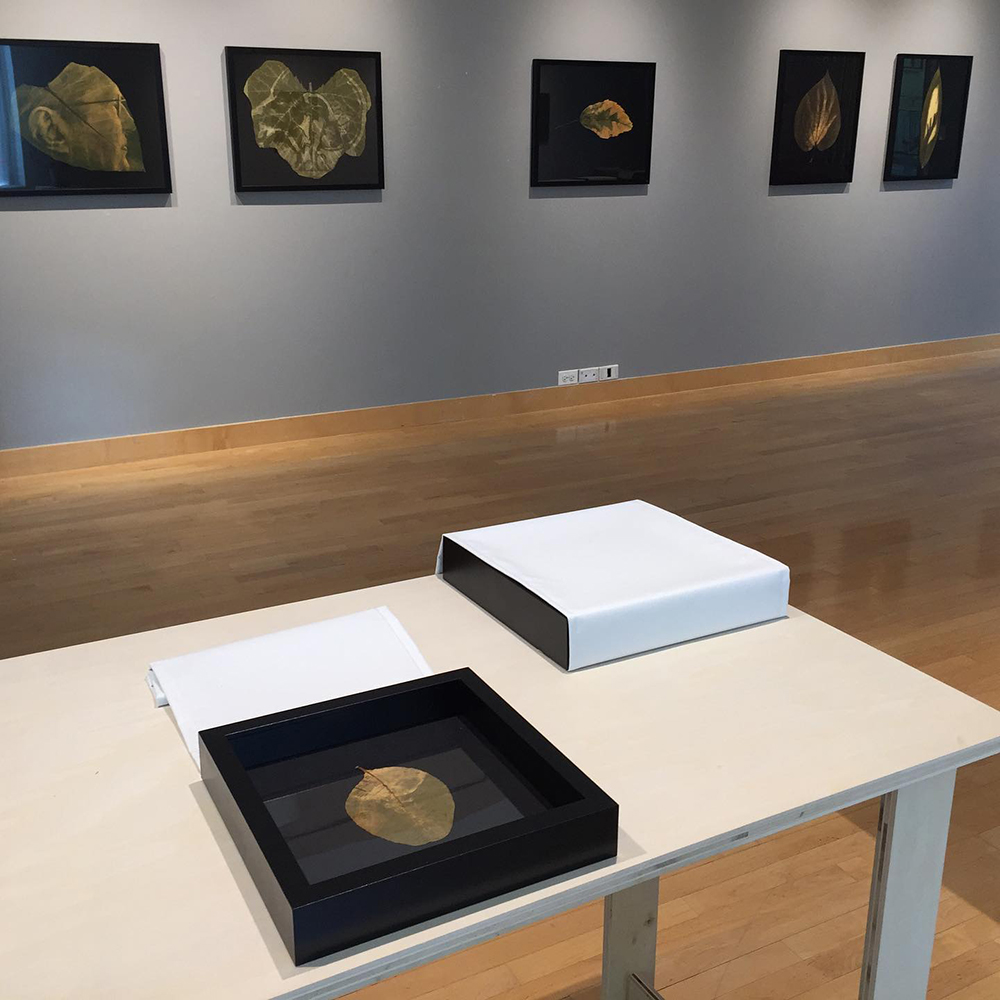
Installation view of Senescence at the Foster Gallery in Dedham, MA, 2019. Image description: Large-scale archival pigment prints from chlorophyll print scans are displayed on the gallery walls. The framed chlorophyll-printed leaves, covered with blackout cloth, are displayed on tables in the middle of the gallery. One chlorophyll print has its cloth cover flipped open displaying the leaf.
AS: Can you share more about how you exhibit chlorophyll prints and why you made those decisions?
MB: Chlorophyll printing is a process where images are printed directly onto leaves using photosynthesis. I do not fix the leaves so they continue to fade and degrade over time. The method of covering the framed leaves with blackout cloth was first devised during an artistic collaboration with Shin Yu Pai. It was a creative answer to protecting the leaves from UV light while being exhibited. And then at the opening of our show Animating Archives, something really interesting happened. People were having these really intimate viewing experiences with the leaves, lifting up the cloth, peeking into the display boxes, spending time with the pieces.
While the presentation method occurred out of necessity I believe there is so much richness in the presentation in relation to the ideas behind the work. While it does provide a more intimate viewing experience the viewer’s act of looking adds to the degradation of the leaf. To me this starts to hint at the politics of looking or staring. And the push and pull of how disabled experience can be simultaneously private/personal and public/political.
I am conscious of the fact that I have made the decision to not fix the leaves and allow them to degrade overtime, underscoring the bodily vulnerability we all share. And at the same time I have gone to careful measures to protect the leaves from the UV light that accelerates their degradation. I am interested in that in between space and in the contradiction of it. In some ways I think it relates to the contradictions I live with in my body and how those contradictions have allowed me to understand and dismantle binary thinking (normal/abnormal, healthy/sick)
For example I have parts of me that are deteriorating more rapidly, I was 25 and told I had the hip of an 80 year old. I am simultaneously young and old. Some days I move with ease and other days my body is stiff. This has allowed me to embrace uncertainty, have flexibility in how everyday will not be the same, to understand time as relative and not fixed or linear, that change is really the only constant, and that “normal” is a complete construct.
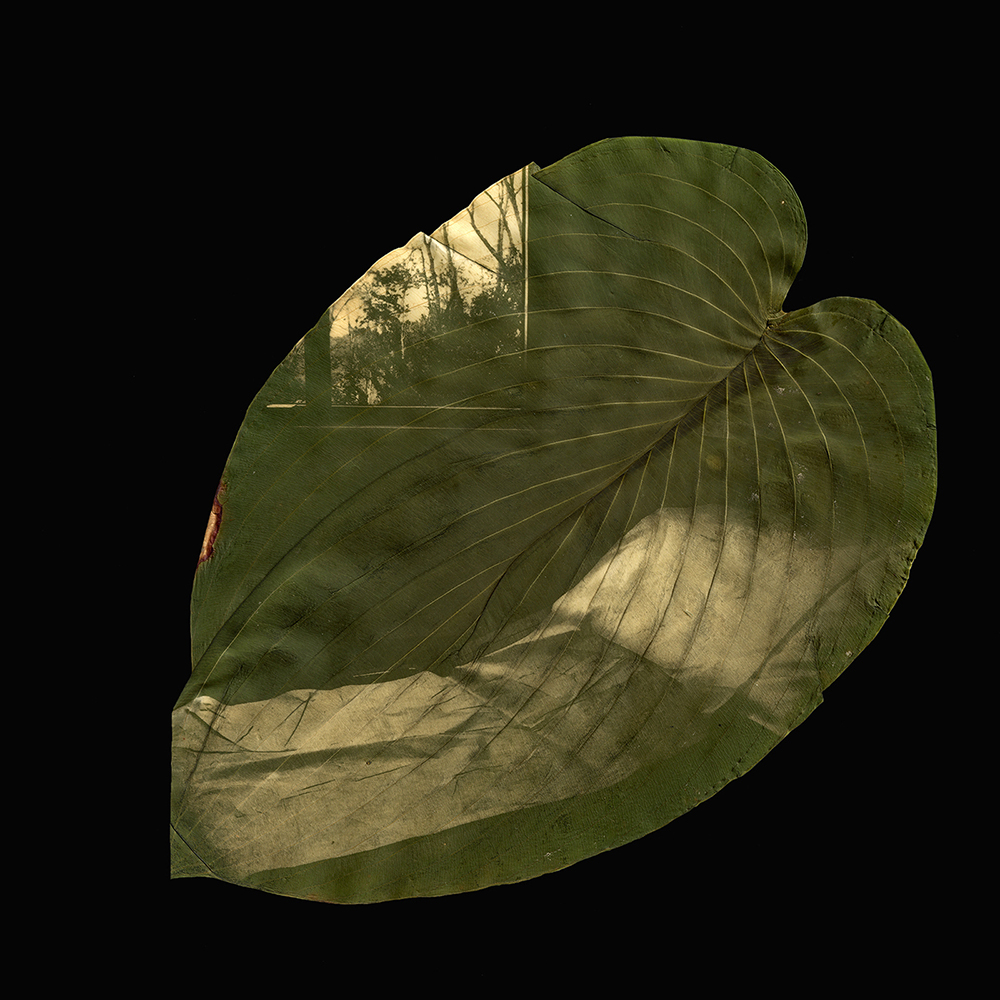
©Megan Bent, Untitled (180,000 Lost and Counting) August 26, 2020, Chlorophyll print. Image description: A heart-shaped hosta leaf on a black background. Printed in the chlorophyll is an empty hospital bed, lit by the natural light of a nearby window.
AS: Who or what is inspiring you these days?
MB: My biggest artistic influence is Felix Gonzalez Torres, hands down. I love the poetics of his work, the minimalism and openness. Within the quiet poetics is a strong deconstruction showing the cracks in the politics and stigma during the AIDS crisis. His work expanded the ways I think about process, portraiture, photography, and time. I have been really deeply appreciative of the work of Carolyn Lazard, the way they write about illness (for example How to be a Person in the Age of Autoimmunity) and the ways Lazard’s work poignantly uses the mundane and minimalism to assert disability experience and the politics and labor of disability.
Being as a guest editor for Lenscratch has been a great experience, it has meant a lot to connect and converse with the featured photographers and get to learn more about them and their practices. I am deeply grateful for those conversations and connections.
I have been truly grateful for the remote access work of Critical Design Lab, Kevin Gotkin, Yo-Yo Lin, moira williams, Aimi Hamraie, and many others. The remote access movement and culture that was introduced to me during the pandemic has been something that changed my understanding and thinking around disability and access for the better. It helped me realize the ways I had been pushing myself to try and fit normative society and embrace the ways I could show up authentically and begin to understand what my access needs are. And how when we center access at the core of something, not a box to check off, it creates space for creativity, safety, joy, care, and crip magic.
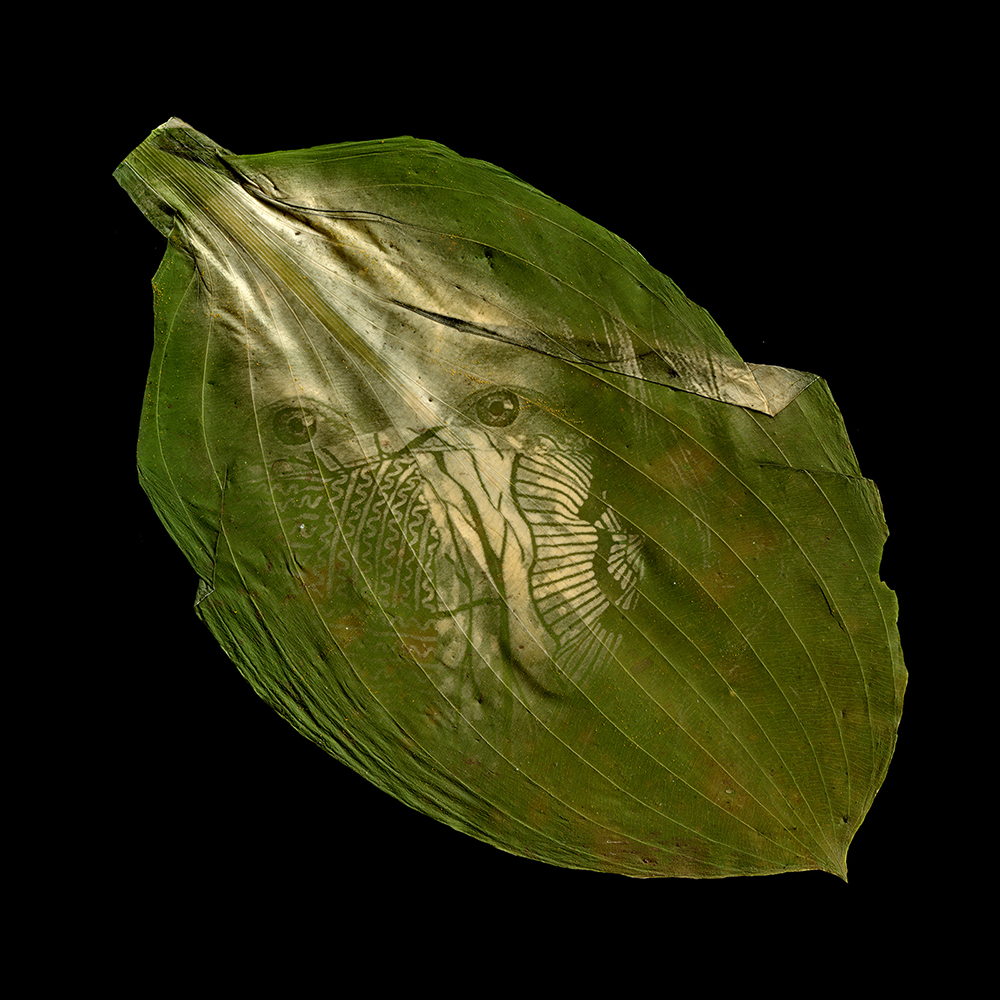
©Megan Bent, Quarantine Day 280, 2021. Chlorophyll print. Image description: A green oval-shaped hosta leaf on a black background. The leaf is going diago-nally across the frame with the leaf stem in the top left. Printed into the chlorophyll is a self-portrait where my eyes and face masks are visible. The rest of my pale face and dark hair gradually disappear into the leaf.
AS: What has your advocacy brought to your life?
MB: I think about how many years it took me from becoming ill or experiencing disability to discover that there was this vibrant community and rich history, and different theories about claiming disability, disability aesthetics, crip time, theories that put words to feelings I didn’t yet have the vocabulary for. And I feel like a big impetus for me is to find ways to share this knowledge so it’s less hidden and so that hopefully it doesn’t take someone who is newly disabled as long as it took me to find it. Because when I found it (history, community, culture, pride), it changed everything for the better.
For example, in late 2019 right before the pandemic I had a solo exhibition of my chlorophyll prints, Latency, at the Austin Central Library Main Gallery. It’s the beautiful new(ish) library downtown that’s six stories and has multiple galleries. Knowing I was going to be exhibiting in a library I curated a selection of books on Disability Justice, artistry, and culture. Installed in the exhibition were hundreds of copies of the curated reading list detailing where the books were located inside the library. I also collaborated with my brother (who is also an artist) to create an illustrated zine outlining some of the artists and research that have influenced my decisions as an artist. We made 200 copies of the zine that were also available to gallery visitors to take with them. I was very happy that when I returned to deinstall all copies of the zine and reading list were gone and had been utilized by the local community.
I also think it’s important to share that in the pandemic I have experienced advocacy fatigue. There have been so many times I have had to be over assertive to stand up for myself and try to receive the respect and accommodations I deserve. Having to continually advocate to have your rights and dignity met, it can be very traumatic and exhausting. And there have been moments where I have felt like I need to step back after being burnt out from the emotional labor of it all.
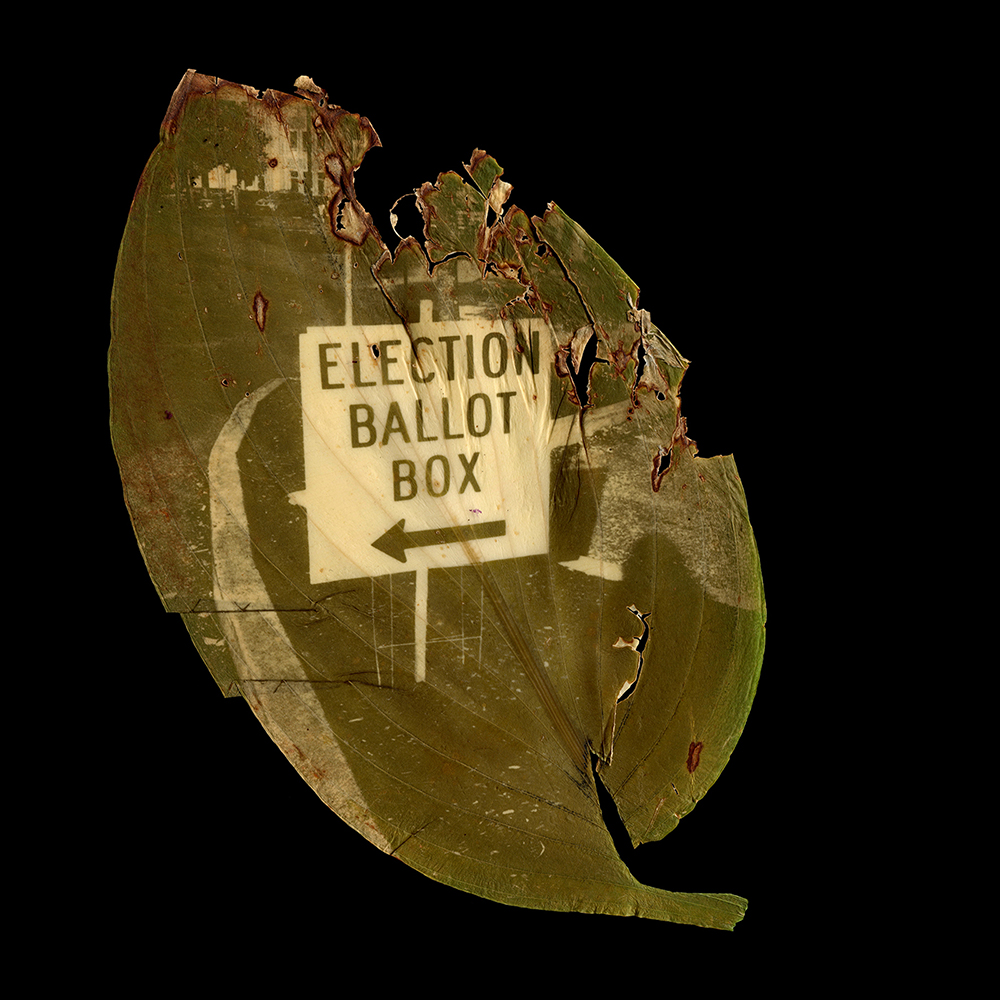
©Megan Bent, Quarantine Day 213 (#CripTheVote) 2021, Chlorophyll print, Image description: A hosta leaf on a black background. The top of the leaf is tattered and full of holes. Printed in the chlorophyll is a curb with a sign “Election Ballot Box” and an arrow pointing to the left.
Turning Arrows Into Flowers
When my bicycle became a mobility aid I cycled around wearing an 8×10” pinhole camera on my back making an exposure for the duration of each ride. With the blue sky as my background, my movement combined with the sunlight mapped my travels onto the negative. This celebratory act of making transformed my movement into agency.
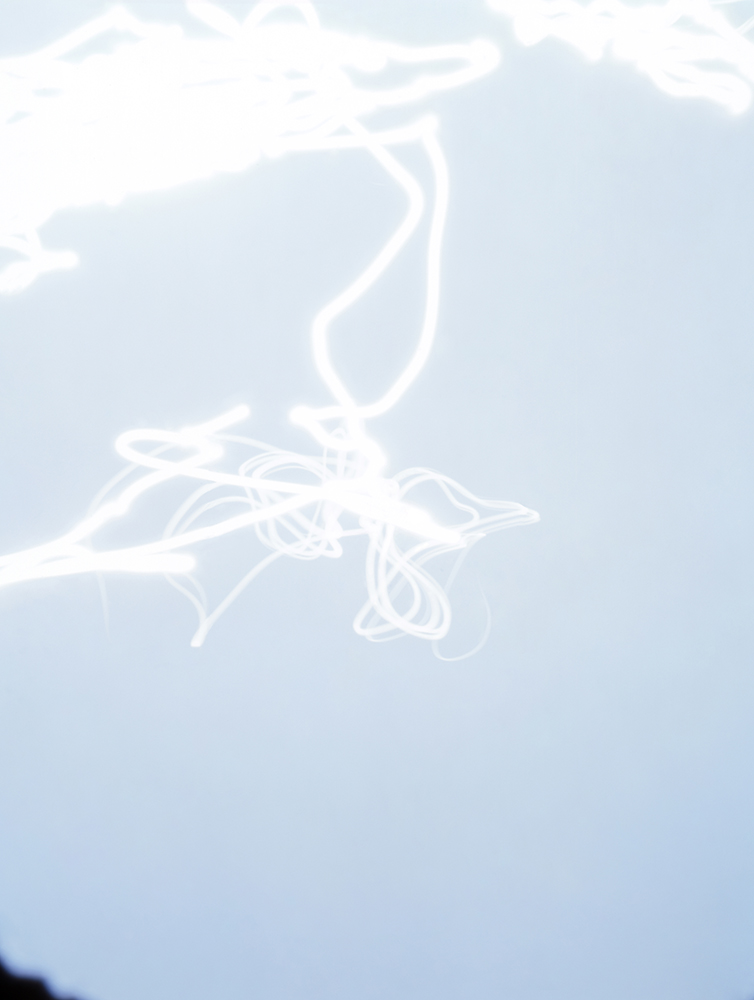
©Megan Bent, September 29, 2010 4:14 – 4:56 PM, 8×10 Pinhole photograph Image description: My movement mapped by the sun onto the negative. Bright white rounded squig-gles of my movement start in the middle of the image and move up, filling the top of the frame.
AS: Turning Arrows Into Flowers is such a wonderful conceptual way to express metaphor and time. Can you speak to the importance of this work for you?
MB: Yes, I really love this work. This is my first body of work where I started to share my disability publicly. This was during graduate school when it was becoming harder for me to walk, but riding a bicycle was like a mobility aid for me. And I have always loved cycling. I wanted to make work celebrating my movement and make it as minimal as possible. So I wore an 8×10 pinhole camera creating an exposure for the duration of my ride. With the blue sky as my background the sun traced my movement onto the 8×10 film.
I wanted to map my movement in an abstract way and this project was also the beginning of abstractly mapping my movement as a larger practice. Now I create site specific installations where I map my movement across all surfaces of the gallery through drawing. In these line drawings there is no hierarchy of movement and instead posits my movement as something that is ever changing and entangled on a continuum. I recently in an exhibition at Alternative Space 298 in Pohang, South Korea titled A Room For Duration where I created an installation mapping my repetitive walking paths for the two years+ of the pandemic.
Posts on Lenscratch may not be reproduced without the permission of the Lenscratch staff and the photographer.
Recommended
-
Ragne Kristine Sigmond: Portraits of Painterly LightDecember 2nd, 2025
-
Mary Pat Reeve: Illuminating the NightDecember 1st, 2025
-
Ricardo Miguel Hernández: When the memory turns to dust and Beyond PainNovember 28th, 2025
-
Pamela Landau Connolly: Columbus DriveNovember 26th, 2025
-
MATERNAL LEGACIES: OUR MOTHERS OURSELVES EXHIBITIONNovember 20th, 2025

